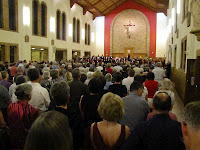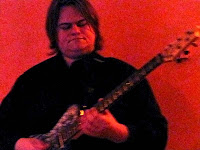 Sally observed it wasn’t jazz, but Handel’s Messiah well deserves a post on CJ. The Canberra Choral Society performed it again this year at St Christopher’s Cathedral, the cream brick Catholic cathedral at Manuka. We went to the first of two performances and it was an immensely satisfying experience. The Cathedral is not my favourite building around town, the acoustics were heavy with reverb that made for a loud but somewhat mushy sound and there was frequent traffic noise and Harley splutter outside on Canberra Avenue, but nonetheless this was a treat. It was the long performance with the full 3 Acts, verging on 3 hours with the interval. I thought this was a daring choice and all praise is due. This was my first Messiah (a late starter) but I was glad to hear one where the three parts, dealing with the Birth, Passion and Aftermath, were present, and the familiar arias and the exultant Hallelujah Chorus were in their right places. It was long but the time passed like a breeze. I was impressed by the stamina of both performance and audience. Pews are not the most comfy places to spend three hours, and I noticed the audience stirring but it was uncomplaining and stood for the famed Hallelujah Chorus, as people apparently have since King George 2. I expected that we would be too casual for that these days, but no. It was a pleasant surprise. And the applause was deafening at the end, so the effort was much appreciated.
Sally observed it wasn’t jazz, but Handel’s Messiah well deserves a post on CJ. The Canberra Choral Society performed it again this year at St Christopher’s Cathedral, the cream brick Catholic cathedral at Manuka. We went to the first of two performances and it was an immensely satisfying experience. The Cathedral is not my favourite building around town, the acoustics were heavy with reverb that made for a loud but somewhat mushy sound and there was frequent traffic noise and Harley splutter outside on Canberra Avenue, but nonetheless this was a treat. It was the long performance with the full 3 Acts, verging on 3 hours with the interval. I thought this was a daring choice and all praise is due. This was my first Messiah (a late starter) but I was glad to hear one where the three parts, dealing with the Birth, Passion and Aftermath, were present, and the familiar arias and the exultant Hallelujah Chorus were in their right places. It was long but the time passed like a breeze. I was impressed by the stamina of both performance and audience. Pews are not the most comfy places to spend three hours, and I noticed the audience stirring but it was uncomplaining and stood for the famed Hallelujah Chorus, as people apparently have since King George 2. I expected that we would be too casual for that these days, but no. It was a pleasant surprise. And the applause was deafening at the end, so the effort was much appreciated.



 It was a small orchestra with a light presence that was sometimes overshadowed when the voices took flight. But it had a lovely courtly baroque tone that benefited from the reverb. Clear, fat trumpet ringing through (beautifully resonant and very different from a jazz trumpet tone), bassoon or oboe evident at other times, the strings fairly restrained with 7 violins, 2 violas, 2 cellos and a double bass. Organ and a harpsichord that presumably played the original basso continuo part. The choir was 21 sopranos, 30 altos, 10 tenors, 14 basses and there were arias and recitatives for SATB - Rebecca Collins (soprano), Christina Wilson (mezzosoprano), Christopher Saunders (tenor) and Stephen Barnett (bass) - and the whole was directed and conducted by Peter Pocock.
It was a small orchestra with a light presence that was sometimes overshadowed when the voices took flight. But it had a lovely courtly baroque tone that benefited from the reverb. Clear, fat trumpet ringing through (beautifully resonant and very different from a jazz trumpet tone), bassoon or oboe evident at other times, the strings fairly restrained with 7 violins, 2 violas, 2 cellos and a double bass. Organ and a harpsichord that presumably played the original basso continuo part. The choir was 21 sopranos, 30 altos, 10 tenors, 14 basses and there were arias and recitatives for SATB - Rebecca Collins (soprano), Christina Wilson (mezzosoprano), Christopher Saunders (tenor) and Stephen Barnett (bass) - and the whole was directed and conducted by Peter Pocock.What glorious, exultant, dignified, elegant, rational music it is! Lines echoed by passing between voices and on to instruments; big and joyous interval jumps, and shapely lines. Apparently Handel is famous for word-painting where the melody mimics the meaning of the lyrics, so lines rise to mountains and fall to valleys, and “crooked” alternates crookedly between B and C#. I heard a unison bass and bassoon line that surprised and amused me. But always the neat cadences to confirm dignity at the end of scenes. I enjoyed it immensely, and the final applause was long and enthusiastic, seemingly beyond the expectations by the performers. In the end, I felt the words were strangely other-worldly (no-one much chats about exalted valleys, easy yokes or feeding flocks these days or even walking in darkness) but the rational baroque music fits well enough with modern rationality in architecture and politics and economics. We left with high spirits and much joy to take on the Christmas season. Truly a fabulous outing, so thanks in spades to my neighbour Trish and the rest of the performers. BTW, ArtSound were recording the Saturday night performance, so keep you ears tuned for the replay.















































